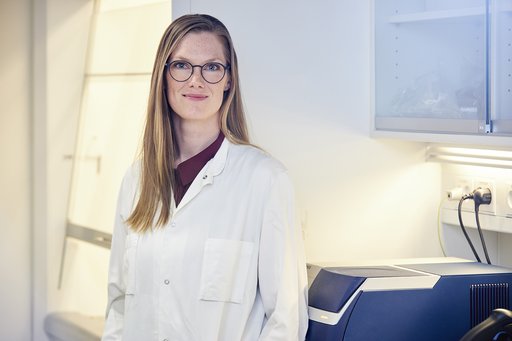Cecilie Hermansen

New Shortcuts to Predicting Functional Properties in a Soil Layer
Using new analytical methods, Cecilie Hermansen has made it easier to assess the risk that spraying a specific piece of land with pesticides will lead to contamination of the drinking water.
By Filip Graugaard Esmarch
Cecilie Hermansen arrived at Aarhus University with a Master of Engineering in Environmental Technology from Aalborg University.
‘My master’s thesis focussed on discovering fast methods for determining soil properties, which may be used to assess its sensitivity to contamination. My supervisor encouraged me to take my soil samples to Foulum, because they had a clever instrument for doing soil measurements. In Foulum I soon became fascinated with the ability to determine a lot of soil properties from one really fast measurement’, she says.
Her fascination led to a PhD study at the laboratory at Foulum, where she continued to study the subject of her master’s thesis. She has attracted international attention for results that show how use of the ‘clever instrument’, a so-called vis-NIR spectrometer, may be expanded.
New Package of Properties
‘Visible near-infrared spectroscopy illuminates a soil sample using various wavelengths in the visible near-infrared area. The spectrometer then measures the amount of light that is reflected. And the shape of the displayed spectrum is affected by the properties of the soil’, Cecilie Hermansen explains.
vis-NIR spectroscopy was already an established method for analysis of the composition of soil layers, e.g. its content of clay, silt and organic material. But Cecilie Hermansen discovered a shortcut to measuring the soil’s sensitivity to contamination from, among others, the herbicide glyphosate and the plant protection product phenanthrene.
‘In my PhD I have added a package of functional soil properties to the list of soil properties that can be determined by vis-NIR, and that you need to know to assess the sensitivity to pesticide leaching’, she says.
One Measurement to Cover Everything
In that connection, some of the main properties is the soil’s ability to transport and absorb water, that is, the degree to which some substances bind to the surface of the soil. It is expensive and time-consuming to do using traditional laboratory methods, just as you need a significant number of soil samples because the properties of the soil may vary quite a bit over a short distance. However, Cecilie Hermansen has succeeded in establishing a mathematical model which in a few minutes can predict the adsorption properties of the soil based on the shape of the spectrum from a vis-NIR measurement.
‘It may take a day to scan just under 100 soil samples using the spectrometer. By comparison, it took me a year using traditional methods to complete the measurements I needed for the mathematical model. However, what makes it great is that once you have the spectrometer measurements, you have a database that can be used to measure the other soil properties you wish to identify, i.e. based on the same measurements’, she says.
She still works at Foulum, now doing a postdoc, and she is still working on the promising methods that may, among other things, be used to improve risk assessments in connection with ground water contamination.